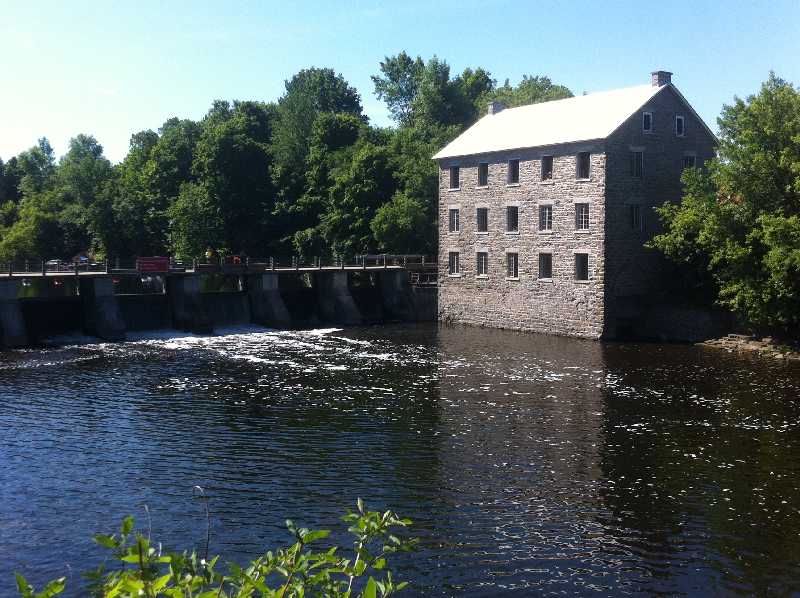
The photo above is of historic [Watson's Mill] located on the banks of the Rideau River in Manotick Ontario, just a few kilometers south of Ottawa. The history of this 1860's heritage mill goes into greater detail in this [Wikipedia] entry for anyone who may be interested. My wife and I had a chance to visit the mill in late June while we were back in Ontario for a few days of sightseeing and to attend our niece's wedding. I'd done a little research in the weeks prior to our trip and discovered that Ontario has a good number of old mills that have been preserved over the years,Watson's Mill being one of the few (or only one) that still produces flour. We'd driven down from Ottawa that Wednesday morning having spent the day before on a fascinating tour of our national capital's historical sites and museums. We arrived at the mill about 30 minutes before it was due to open so put the time to good use exploring the area and taking a few exterior shots of the mill and it's lovely surroundings on this sunny, blue sky, perfect summer morning.
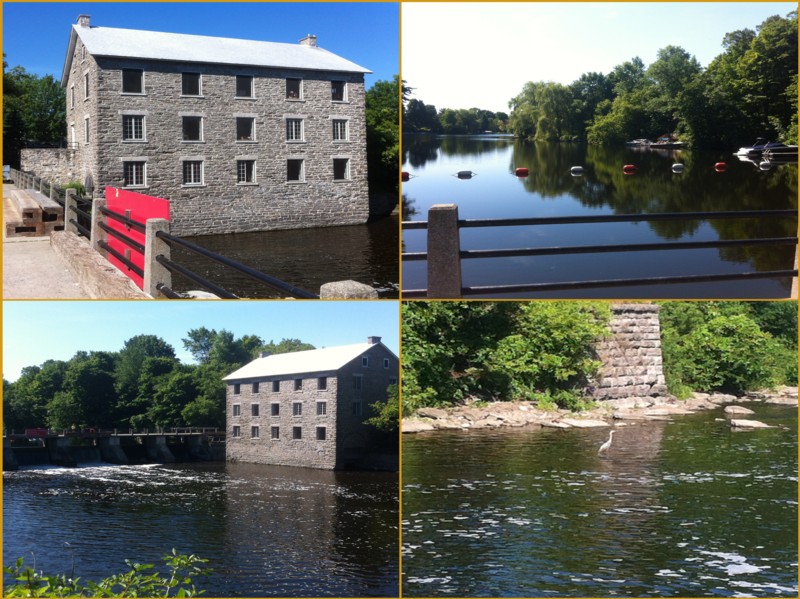
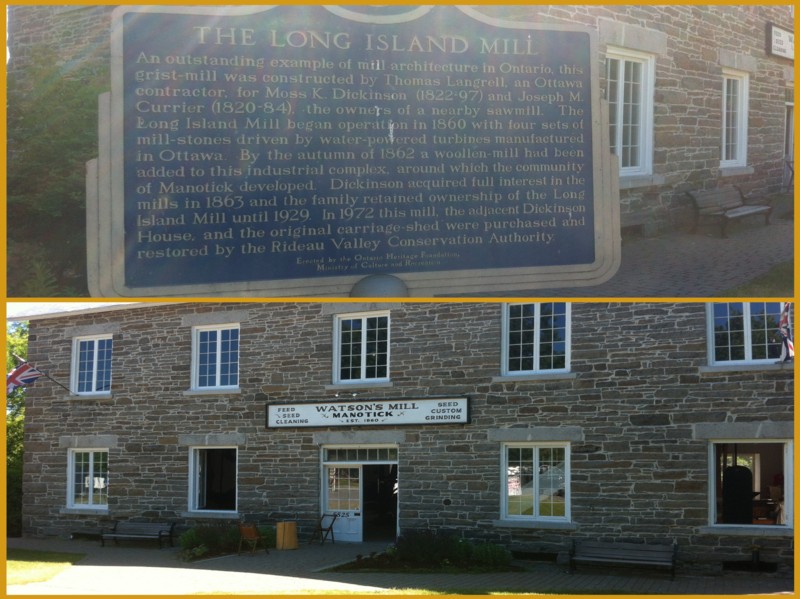
The mill offers the option of a guided tour, or if you prefer you can just browse around on your own. We decided to do our own thing since every section of the mill has information boards posted explaining how the different stages of the milling process take place and the machinery employed. We started out on the lowest level where the river runs under the mill to power the turbines that run the mill are located, then worked our way up floor by floor to see how the grain progresses through the mill using a belt and gear driven conveyor system.The grain travels up and down several times over 3 floors with various parts of the process taking place at each stage. [ Here is a link] that explains the process in better detail than I'm willing to get into here but the illustration doesn't come close to describing the elaborate set up of all the various milling components and how they function together as one large machine. I would loved to have seen the mill while it was running to get a better sense of this, but production is limited to one day a week (Sunday) during tourist season.

The last stop on our mill tour was the gift shop to pick up a couple of bags of the freshly milled flour to take home for myself and a friend.
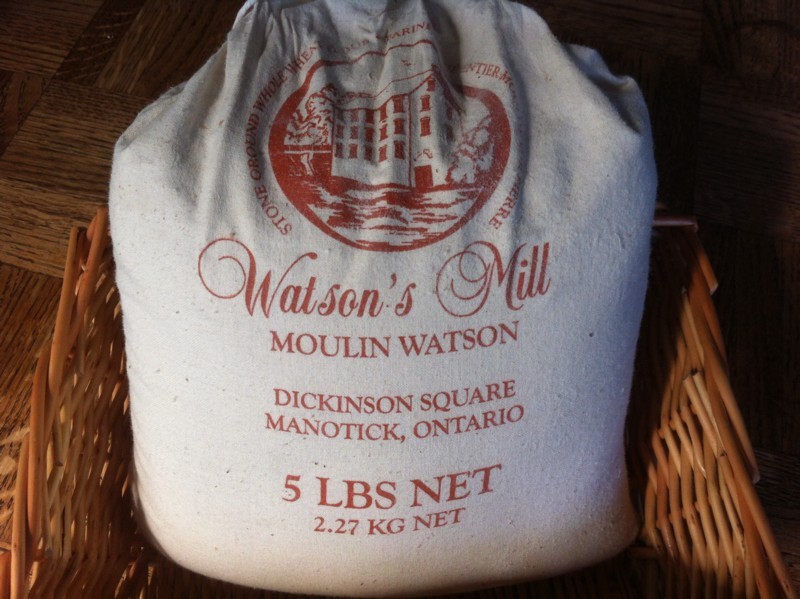
They had an open bag of the flour available that one could reach in and sample the texture of before purchasing, which of course I did. The flour is milled from Ontario Red Fife wheat, a much softer variety than the prairie grown Red Fife that I'm familiar with and has a very silky feel to it, reminding me more of a whole wheat pastry flour than a bread flour. Just around the time I started asking questions of the lady behind the counter regarding the flour, one of the millers happened to stop by for a break from his morning run and was quickly directed over to me. He told me that they typically will sift off 30% of the bran and re-mill it back into the batch, which along with the softer nature of the grain would account for it's fine texture. He went on to assure me that the flour does make very good bread and hoped I enjoyed working with it. Much as I would have liked to have stayed and chatted with him a while longer, we had to be on our way as we still had a long drive ahead of us to get to our destination of Port Hope on the shores of Lake Ontario where the wedding was to take place.
When we arrived back home from Ontario and had unpacked and settled in I began looking through some of my books for a recipe to use the Watson's Mill flour in, deciding to try Dan Leader's Poilane inspired Whole Wheat Sourdough from “Local Breads” that uses an 80% ratio of whole wheat in the formula. The first mix didn't produce the kind of results I was after mainly because of my impatience in wanting to get some bread made that I could have for sandwiches that week. The levain I'd made using the Watson's was extremely lively but the dough hadn't been developed sufficiently, nor had the bulk ferment been long enough for a full and even fermentation.

The loaf made the following week was better developed and fermented, with a mild sour flavour and slightly sweet background to it, that if I hadn't known better would have guessed contained some honey or sugar in the mix. Generally, I thought the loaf was OK but somehow it wasn't hitting any high notes for me either.
By the time I was ready to mix a third loaf using the Watson's flour the appeal of a high ratio whole wheat bread had paled and instead I chose to make a basic country loaf vaguely similar to Chad Robertson's Tartine bread. Starting with an all white flour 100% levain fermented for 8 hours, it was then converted to a stiff 50% levain for an additional 8 hours before adding it to a mix of 83/17 percent White AP to WW flour.
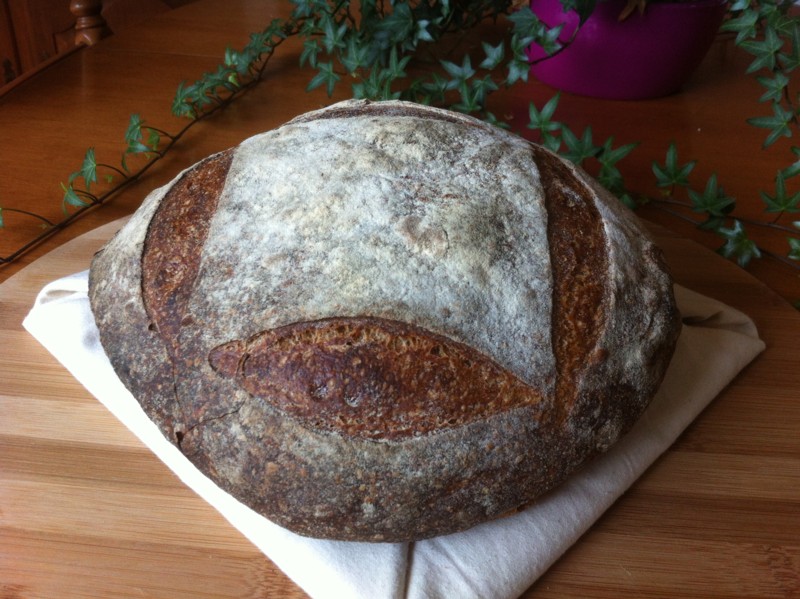
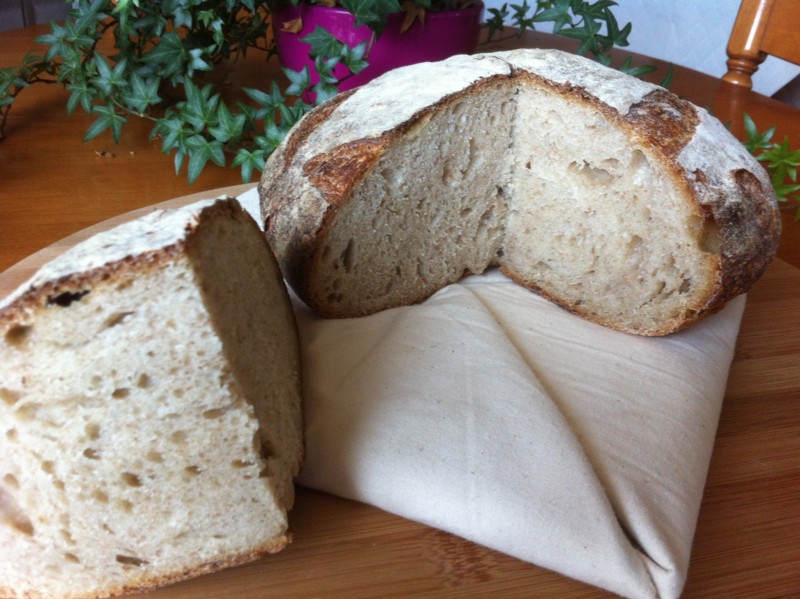

This produced a bread that fell right into my preferred flavour range with the kind of medium sour tang I love, complimented by the same hint of sweetness noted in the previous loaf. The contrast of handling and flavour characteristics between the Ontario grown Red Fife and Saskatchewan RF is significant in my opinion. The soft Ontario flour requires a much more aggressive approach when it comes to developing a high WW ratio dough during the initial kneading, with several stretch and folds needed throughout the first 90 minutes of bulk fermentation, while the prairie grown RF might need only one or two . In terms of flavour and fermentation the Ontario grown grain has a milder, sweeter profile to it than it's spicier, more herbal flavoured prairie cousin. Both flours ferment readily, producing very active and healthy leavens in short order, but lend distinctively different flavour nuances to the finished loaf. For the relatively small amount of Watson's Mill flour I have left remaining,this recipe or similar low ratio WW flour formulae...perhaps some scones as well, will be how it's used in order to stretch it out as much as possible, our next visit to Ontario a few years away. Recipe for the Basic Country loaf [HERE] and Procedure is [HERE]
Franko
- Franko's Blog
- Log in or register to post comments
Great Trip Franko! How fortunate you are to witness an operating watermill, and win a bag of fresh flour before the journey home! Thanks for uploading the beautiful photos. Your breads are simply fabulous, even the first one. The second one has a beautiful crumb. The crust on all loaves are great! Which only goes to show your talent and skills with dough handling. This is almost PERFECT, Franko.
Oh, and welcome back!
Khalid
Hi Khalid,
Thanks my friend for those kind words and happy that you enjoyed the photos. I'm glad I decided to do some research and find this mill online before we left. Being just a little off our route to Southern Ontario, I would have kicked myself If I discovered it's existence after we got home. The workings of the mill were fascinating but the gorgeous setting of the mill is what will stick in my memory for years to come. Hope your doing well and on the mend.
Best wishes,
Franko
Looks like a wonderful trip. Thanks for sharing, Franko.
Best,
Floyd
Thanks Floyd,
The trip was excellent indeed and couldn't have come at a better time to get away from the Juneuary we were having on the South Coast of B.C. at the time. Ontario has some very pretty countryside and lovely old towns to explore and I'm looking forward to seeing more of it in the future.
Cheers,
Franko
Franko,
Thank you for the tour :-). Your detailed description of the building left me with a sense of awe in that previously I had imagined a water powered mill simply to be a large building with stones for grinding wheat and pretty much nothing else. From your writing about what you saw and read I now know that what I am looking at when looking at a mill is a building that is essentially a machine unto itself.....amazing. Almost as though it is alive...
Your breads all look good to me :-) I am partial to 100% whole grains so your first 2 loaves look just fine and I have people around here who would delight in them...
Thanks for posting your photos and for taking the time to write about what you saw. I really appreciate it.
Take Care,
Janet
Hi Janet,
From what I could gather this mill was 'state of the art' at the time it was constructed. I was surprised to find it was powered by six turbines, assuming that a single water wheel was housed inside the structure when I first saw the building. Just from what I could see while the mill was idle this would have been quite a hazardous place to work. The millers would have needed their wits about them at all times to keep all their limbs intact. In fact, the wife (of 6 weeks) of one of the original owners was killed in the mill when her long skirt caught in one of the turbine powered steel shafts, throwing her against a support pillar. Like you, I didn't have a full appreciation of the complexity of these old mills , so our little tour was certainly an eye opener in that respect. Glad I was able to share it with you and others. Thanks so much for your compliments on the loaves. I like high ratio WW breads for a change but couldn't eat them on a regular basis.
All the best,
Franko
Thanks for sharing your experiences at the Mill. I appreciate your details about your experimentation with the flour and it looks like in the end you had a more than satisfactory result.
Funny that the sign says "Long Island" as that is where I live, but in New York.
Regards,
Ian
Hi Ian,
I was a little confused about the "Long Island" part, but discovered that further along the Rideau River there is a long island near where the first settlement was built. The Ojibwa word for island in the river is Manotick, the name of the town that eventually became the main settlement and where the mill is located . It always interesting to work with a totally new flour...sometimes a little more interesting than I'd like, but the learning experience is what makes it worthwhile for me. Thanks for your comments and good to hear from you!
Best,
Franko
Hi Franko,
So good to see your post showing the historic and picturesque place you visited, and your breads, just as beautiful :^)
Thank you for sharing some of the Watson's Mill flour with me! I wanted to make a mild, sweet-tasting loaf - and this flour was just the thing when making Cliff Leir's 50% Whole Red Fife Wheat Bread that MC so kindly wrote about.
The bread turned out exactly as I hoped it would flavor-wise - sweet, fresh, wheaty, rich, and possibly even fruity
(I was really trying to concentrate when tasting this bread, to see what flavors I could pick up!).
This really is a special flour, from a special place, and I am so grateful you sent me some to bake with.
You've done a wonderful job with the breads you baked with this flour - the scoring on the last one is spectacular -
it must have been difficult to cut into that loaf (such a beauty)!
:^) breadsong
Hi breadsong,
I'm happy that this flour delivered the sort of qualities you were hoping for when you made Cliff Leir's 50% WW RF Bread. The sweet background this flour gives the finished loaf is remarkable isn't it? Can't say that I've ever run across a flour, particularly a whole wheat, that has this sweet flavour quality to it. I wonder if this is typical of Ontario RF or if it's just this particular harvest. Whatever the case, it's my pleasure to have shared some of it with you as I know you'll produce some top notch loaves/pastries with it. Thanks for your compliments on the bread and the scoring! The third time was the charm for sure. :^)
Franko
tracked down such interesting mills and the flour they produce. Your loaves look great and the third just fantastic. It seems like a high quality flour, just needing some experimentation to figure out how to use it best. -Varda
Hi Varda,
Before I joined this site the idea of visiting a mill would have been waaay down on the list of things I'd want to see on vacation unless it'd been converted to a pub or restaurant, which is the case with many of the old Ontario mills. The opportunity to work with an entirely different flour or dough than what I'm used to is a welcome challenge and a great learning experience, something I know you can relate to having seen similar challenges that you've taken on and mastered. Thanks for your kind words on the loaves, Varda, greatly appreciated!
Franko
Franko, I think my heart skipped a beat when I saw the first mill photo. So beautiful, and I love hearing about the different breads you chose to try with the soft, sweet flour. Love the gloss on the crumb of the last loaf!
My favorite SD loaf also has a similar whole grain content, about 16%, of which 4% is whole rye and the rest whole (red) wheat, yum.
Hi Julie,
I must admit that I had my own moment when I first saw the mill from across the river. The whole scene was truly one of the most lovely I've had the privilege of capturing either in my memory or a photo. The mid morning light cast it in such a way that my photographic skills and phone camera weren't capable of really doing justice to it, but very happy to share the beauty of what I did mange to record with you and the members/ guests of the site.
Using the Watson's in a high (80+) ratio mix probably isn't the best percentage for this flour to allow it's flavour to shine,.. at least not for me. I almost added some rye flour to the 3rd mix, similar to your own SD loaf, but wanted to see how the flavour of the flour would come through, minus any non-wheat flavours involved to confuse things . Now that I have a better understanding of the Watson's flavour characteristics, your 4%, or perhaps a 6% inclusion of whole rye would be just the ticket for the next bake I do with it.
Thanks Julie for your comments and compliments on my experiments. :^)
Best,
Franko
there myself after your fine post. Very nice breads too. Your ecperiments paid off.
Thanks dabrownman! I'm glad you enjoyed the post and appreciate your compliments on the breads.
All the best,
Franko